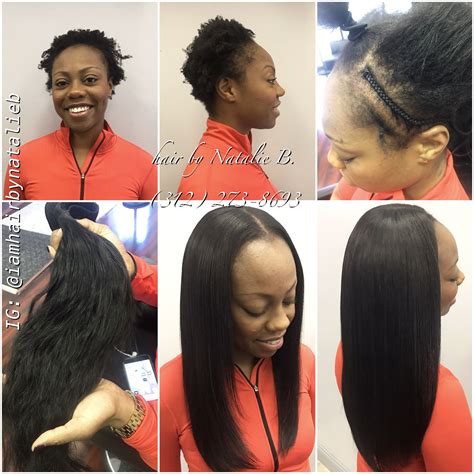Transform your hairstyle with the exquisite art of sew-in weave hair, a technique that seamlessly blends natural hair with extensions for a stunning, voluminous look. This versatile method offers a myriad of benefits, from enhancing length and volume to experimenting with different colors and textures.

-
Enhanced Length and Volume: Instantly achieve long, flowing locks or add fullness to thin hair, creating a dramatic and flattering effect.
-
Versatile Styling Options: Experiment with various hair lengths, textures, and colors to customize your look and match any occasion or outfit.
-
Protective Hairstyle: Sew-in weaves protect natural hair from heat styling and breakage, giving it time to grow and thrive.
-
Low Maintenance: Compared to other hair extensions, sew-in weaves require less daily maintenance, making them a convenient option for busy individuals.
-
Long-Lasting: Sew-in weaves typically last for 6-8 weeks with proper care, providing a long-lasting solution for your hair enhancement needs.
1. Machine Sew-In
- Uses a sewing machine to attach extensions to natural hair in a series of tight cornrows.
- Provides a secure and durable hold.
- Can be time-consuming and requires professional installation.
2. Hand Sew-In
- Involves manually sewing wefts of hair extensions onto individual braids or cornrows.
- Offers more customization and flexibility.
- Requires less tension on natural hair, making it suitable for delicate strands.
Materials:
- Hair extensions
- Cornrows or braids
- Sewing needle
- Thread
- Curved hair needle (optional)
Step-by-Step Approach:
- Prepare Natural Hair: Section hair into manageable cornrows or braids, creating a foundation for the extensions.
- Attach Extensions: Use the sewing needle and thread to attach the wefts of hair extensions to the cornrows, starting at the nape and working your way up.
- Tighten Weft: Pull the thread firmly and evenly through the cornrows to secure the wefts. Avoid over-tightening to prevent damage to natural hair.
- Conceal Weft: Use a curved hair needle to pull sections of natural hair over the weft, blending it seamlessly with the extensions.
- Style: Once the weave is installed, style it as desired using heat tools, curl cream, or leave-in conditioner.
In today’s fast-paced world, appearance matters more than ever before. A well-styled, voluminous head of hair can boost confidence, enhance physical attractiveness, and leave a lasting impression on others. Sew-in weave hair provides a convenient and effective solution for individuals looking to achieve their hair goals without sacrificing their natural strands.
1. Consult a Professional
Seek the expertise of a licensed hairstylist experienced in installing sew-in weaves. They can assess your hair type and provide personalized advice on the best technique and extension type for your needs.
2. Choose High-Quality Extensions
Invest in high-quality extensions made from human hair or synthetic materials that mimic natural hair. Avoid cheap or low-quality extensions that can tangle, fray, or cause damage to natural hair.
3. Proper Care and Maintenance
Regularly wash and condition your weave to keep it fresh and prevent tangles. Use a wide-toothed comb and avoid brushing the roots too often. Retighten the weave as needed to keep it secure and avoid slippage.
4. Respect Natural Hair
Always prioritize the health of your natural hair during and after a sew-in weave installation. Avoid excessive tension on your scalp and remove the weave promptly if it causes any discomfort or irritation.
- Hair Type: Different hair types require different weave techniques. Consult with a professional to determine the best option for your natural hair.
- Budget: Sew-in weaves can vary in cost depending on the type of hair extensions and the skill level of the hairstylist.
- Lifestyle: Consider your lifestyle and maintenance routine when choosing a sew-in weave. If you lead an active lifestyle, a weave that requires less frequent maintenance may be a better fit.
- Desired Look: Select hair extensions that match your desired length, texture, and color. Experiment with different options to find the perfect look for you.
Table 1: Types of Sew-In Weaves
| Type | Method | Pros | Cons |
|---|---|---|---|
| Machine Sew-In | Sewing machine | Secure, durable | Time-consuming, requires professional installation |
| Hand Sew-In | Manual sewing | Customizable, less tension on hair | More labor-intensive, may take longer |
Table 2: Choosing Extensions for Sew-In Weaves
| Material | Pros | Cons |
|---|---|---|
| Human Hair | Natural look, versatile styling | Expensive, requires more maintenance |
| Remy Hair | Premium human hair, tangle-free | Very expensive, requires special care |
| Synthetic Hair | Affordable, low maintenance | Artificial look, may not blend well |
Table 3: Maintenance Schedule for Sew-In Weaves
| Task | Frequency | Importance |
|---|---|---|
| Washing and Conditioning | Twice a week | Keeps weave fresh, prevents tangles |
| Retightening | Every 2-3 weeks | Prevents slippage, maintains weave security |
| Scalp Cleaning | Weekly | Removes product buildup, promotes healthy scalp |
Table 4: Troubleshooting Common Sew-In Weave Problems
| Problem | Cause | Solution |
|---|---|---|
| Itching or irritation | Tension on scalp | Adjust the tightness of the weave, use scalp cleaner |
| Tangling | Poor-quality extensions, lack of maintenance | Use a wide-toothed comb, regularly condition the weave |
| Slippage | Loose weft | Retighten the weave securely, check for breakage |
| Breakage | Over-tightening, poor-quality hair | Remove the weave promptly, consult with a professional |
